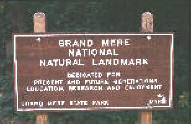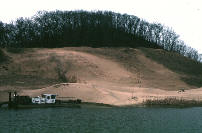Sand Mine Reclamation Grand Mere State Park
The purpose of this project was to complete an ecological restoration of the Peters sand mine at Grand Mere State Park in Berrien County, Mich.
You will need the free Adobe Reader to view some of the files on this page. See EPA's PDF page to learn more.
- Sand Mine Reclamation Grand Mere State Park - Final Report (PDF) (12 pp, 604 K) October 2000
- Sand Mine Restoration Plan Grand Mere State Park (PDF) (25 pp, 89 K) August 2000
- Letter of Agreement between TechniSand, Inc. and Michigan DNR (PDF) (2 pp, 20 K)
Appendix A: Planting Zones Map 22
Appendix B: Global and State Element Ranking Criteria 23
Appendix C: Public Act 451 of 1994 – Part 353 “Sand Dunes
Protection & Management” 24
Appendix D: Public Act 451 of 1994 – Part 637 “Sand Dune
Mining” 25
Appendix E: Critical Dune Areas at Grand Mere
Background and Project Objectives
 The purpose of this project was to complete an ecological restoration
of the Peters sand mine at Grand Mere State Park, Berrien County,
Michigan. Grand Mere State Park is a 985 acre park characterized by one
mile of Lake Michigan shoreline, large oak-forested dunes, several large
blowouts, and three shallow inland lakes behind the dunes (largely
succeeding towards shrub-dominated swamp). An active sand mine is
adjacent to the 1,200-acre dedicated National Natural Landmark that
includes Grand Mere State Park. The overall goal of the project is to
reclaim the sand mine to native species (local genotype) that blend well
with the surrounding natural communities, while demonstrating to
regulators and the sand mining industry a more ecologically-sound way of
reclaiming sand mines. Throughout the project, cooperation between
private industry, state and federal agencies, and the local community
was emphasized.
The purpose of this project was to complete an ecological restoration
of the Peters sand mine at Grand Mere State Park, Berrien County,
Michigan. Grand Mere State Park is a 985 acre park characterized by one
mile of Lake Michigan shoreline, large oak-forested dunes, several large
blowouts, and three shallow inland lakes behind the dunes (largely
succeeding towards shrub-dominated swamp). An active sand mine is
adjacent to the 1,200-acre dedicated National Natural Landmark that
includes Grand Mere State Park. The overall goal of the project is to
reclaim the sand mine to native species (local genotype) that blend well
with the surrounding natural communities, while demonstrating to
regulators and the sand mining industry a more ecologically-sound way of
reclaiming sand mines. Throughout the project, cooperation between
private industry, state and federal agencies, and the local community
was emphasized.
 The project duration was originally set at two years, with a one-year
extension anticipated from the beginning. It was recognized in the
original project narrative that additional time may be needed for
restoration, depending on how quickly the sand mining was completed. As
of September 1, 2000, TechniSand is still completing mining and
contouring of the site. Some slopes have received initial plantings,
but the majority of the site will not be ready for plantings until fall
2000 or spring 2001.
The project duration was originally set at two years, with a one-year
extension anticipated from the beginning. It was recognized in the
original project narrative that additional time may be needed for
restoration, depending on how quickly the sand mining was completed. As
of September 1, 2000, TechniSand is still completing mining and
contouring of the site. Some slopes have received initial plantings,
but the majority of the site will not be ready for plantings until fall
2000 or spring 2001.
 Because mining has not yet been completed, this final report cannot
present the outcome of a completed restoration. The report will
document what was accomplished to date and how the federal funds were
spent. It will be necessary to continue monitoring and implementation
of the restoration plan to ensure all requirements of the plan are met.
The State Park Stewardship Program is prepared to continue this project
until all phases of the plan are carried out. An addendum to this final
report will be completed detailing the progress of the reclamation after
all plants purchased with EPA assistance are installed and monitoring
has continued for at least three years. At that time, a more elaborate
summary can be made of lessons learned through this project.
Because mining has not yet been completed, this final report cannot
present the outcome of a completed restoration. The report will
document what was accomplished to date and how the federal funds were
spent. It will be necessary to continue monitoring and implementation
of the restoration plan to ensure all requirements of the plan are met.
The State Park Stewardship Program is prepared to continue this project
until all phases of the plan are carried out. An addendum to this final
report will be completed detailing the progress of the reclamation after
all plants purchased with EPA assistance are installed and monitoring
has continued for at least three years. At that time, a more elaborate
summary can be made of lessons learned through this project.
The specific objectives of the project are as follows (excerpted from a letter to Project Officer Kent Fuller dated January 14, 2000):
- To complete an ecological restoration of the Manley-Peters (a.k.a. Gullivere-Peters) Sand Mine at Grand Mere State Park to approximate, as near as possible, the natural conditions of surrounding dunes. To accomplish this, we will plant a suite of key native plant species that create the biological framework of the native plant communities likely to occur naturally at this site. Following the initial plantings, the State Park Stewardship Program intends to monitor the growth of these plants and those that naturally establish within the sand mine for many years. Through active management, we will promote succession towards the natural forested dune, prairie, wetpanne, and pond communities that occur nearby within the park.
- To demonstrate to regulators of the sand mining industry a more ecologically sound way of restoring sand mines that promotes the use of a diverse array of native species that would naturally occur on dunes at the site of the mining operation. We intend to demonstrate the feasibility of an ecological restoration effort that uses a diversity of native plants to revegetate the site, rather than the monocultures of beach grass and non-native trees and shrubs often planted to stabilize sand dunes.
- To demonstrate to the sand mining companies that they can do a better job of restoring sand mines to a more natural condition following mining. In addition to benefiting the environment by providing habitat for native plants and animals, such restorations would also boost the reputation of these companies as being more environmentally-conscious.
- To cooperate with private industry, state and federal agencies, and the local community. This cooperation will foster awareness of the importance of conserving the native biological diversity of dune systems for all parties involved. Volunteerism and natural resource education will be promoted throughout the restoration. In addition, the project will involve the development of techniques to restore wetpanne and aquatic habitats, including research on the propagation of native plant species.
![[logo] US EPA](../gif/logo_epaseal.gif)